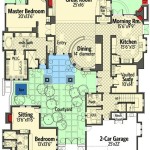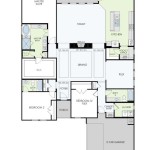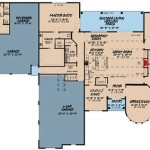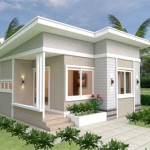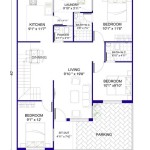House Plans for Two-Bedroom Homes: Maximizing Space and Functionality
Two-bedroom homes are a popular choice for a variety of homeowners, ranging from young professionals and couples to small families and retirees. These homes offer a balance between affordability, manageability, and adequate living space. The key to successful two-bedroom house plans lies in optimizing the available square footage to create a comfortable and functional living environment. This article examines different considerations when selecting or designing house plans for two-bedroom homes, focusing on key aspects such as layout options, storage solutions, style considerations, and potential future adaptability.
Optimizing Layout for Flow and Functionality
The floor plan is arguably the most crucial aspect of any house design, and particularly so for two-bedroom homes where space optimization is paramount. The arrangement of rooms, the circulation between them, and the creation of distinct zones for different activities are all critical to a home’s livability. Common layout styles include ranch-style, split-level, and two-story designs, each with its own advantages and disadvantages.
Open-concept living is a popular choice in modern two-bedroom house plans. This design typically integrates the living room, dining area, and kitchen into a single, unified space. This creates a sense of spaciousness and promotes social interaction. However, careful consideration must be given to zoning within the open space. Furniture arrangement, changes in flooring, and the strategic placement of architectural elements like partial walls or islands can help define distinct areas for cooking, dining, and relaxing, without completely sacrificing the overall open feel.
Closed-concept layouts, on the other hand, separate each room with walls. This offers more privacy and noise control, which can be beneficial for individuals who work from home or prefer a quieter environment. While closed-concept plans might feel smaller, they can be effectively designed with strategically placed doorways and windows to maximize natural light and create a sense of connection between the different spaces.
The placement of the bedrooms is another important consideration. Often, one bedroom is designated as the master suite, typically larger and including an en-suite bathroom and walk-in closet. The second bedroom can serve as a guest room, home office, or children's room. Strategically locating the bedrooms away from the main living areas can improve privacy and reduce noise disturbances.
Hallways, while necessary for circulation, should be kept to a minimum to avoid wasting valuable square footage. Pocket doors or sliding doors can be used in hallways and other areas to save space and improve flow.
Maximizing Storage Space in Two-Bedroom Homes
Storage is a common concern in smaller homes, and two-bedroom houses are no exception. Clever storage solutions are essential for maintaining an organized and clutter-free living environment. Several strategies can be employed to maximize storage space without compromising the aesthetics of the home.
Built-in storage is an excellent way to utilize otherwise unused space. This can include built-in bookshelves in the living room, custom closets in the bedrooms, or even window seats with storage underneath. Built-in storage can be tailored to specific needs and can seamlessly integrate with the overall design of the home.
Vertical storage is another effective way to maximize space. Shelving that extends to the ceiling can provide ample storage for books, décor, and other items. In the kitchen, utilizing the space above cabinets for storage can free up valuable counter space. High shelving can also be used in closets to store items that are not frequently used.
Multi-functional furniture can also contribute to storage solutions. Coffee tables with hidden storage compartments, ottomans that open up to reveal storage space, and beds with drawers underneath are all examples of furniture that can serve both a functional and storage purpose. These pieces are particularly useful in smaller spaces where every square inch counts.
The attic or basement (if present) can be converted into usable storage space. Careful planning and proper insulation are essential to ensure that these spaces are suitable for storing valuable items. Carports or sheds in the backyard can also provide additional storage for tools, gardening equipment, and other outdoor items.
Closet organization systems are crucial for maximizing the storage capacity of closets. These systems typically include shelves, rods, drawers, and other accessories that help to organize clothing and other items efficiently. By optimizing the use of closet space, homeowners can significantly reduce clutter and improve the overall organization of their homes.
Style and Aesthetic Considerations for Two-Bedroom House Plans
The architectural style and overall aesthetic of a two-bedroom home should reflect the homeowner's personal preferences and lifestyle. There are numerous styles to choose from, each with its own unique characteristics and appeal. Popular styles include modern, contemporary, farmhouse, craftsman, and traditional.
Modern house plans typically feature clean lines, minimalist designs, and an emphasis on natural light. Large windows, open floor plans, and simple color palettes are common characteristics of modern homes. These homes often incorporate sustainable materials and energy-efficient features.
Contemporary house plans are similar to modern plans but tend to be more flexible and incorporate a wider range of materials and design elements. Contemporary homes often feature asymmetrical designs, bold use of color, and an emphasis on indoor-outdoor living.
Farmhouse house plans evoke a sense of warmth, comfort, and rustic charm. These homes often feature exposed beams, shiplap walls, and large porches. Farmhouse designs typically incorporate natural materials such as wood and stone, and often include a large kitchen with a central island.
Craftsman house plans are characterized by their intricate details, handcrafted elements, and emphasis on quality craftsmanship. These homes often feature wide porches, exposed rafters, and decorative wood trim. Craftsman designs typically incorporate natural materials and earth-tone colors.
Traditional house plans encompass a wide range of styles that have been popular throughout history. These homes often feature symmetrical designs, formal living spaces, and traditional architectural elements such as columns, moldings, and fireplaces. Traditional designs typically incorporate classic materials and colors.
Beyond architectural style, the interior design should be cohesive and reflect the overall aesthetic of the home. Color palettes, furniture choices, and décor should be carefully selected to create a comfortable and inviting living environment. Natural light is an important element in any design, and maximizing its use can significantly enhance the appeal of a two-bedroom home.
Future Adaptability and Flexibility
When selecting or designing a two-bedroom house plan, it is important to consider potential future needs and how the home can be adapted to accommodate changing circumstances. While the home might currently be suitable for a couple, future plans may involve starting a family, caring for aging parents, or accommodating a growing home-based business.
A key consideration is the potential for adding additional bedrooms or living space. This could involve converting an attic or basement into a finished living area, adding an addition to the existing structure, or even reconfiguring the existing layout to create an extra bedroom or office. Ensuring that the foundation and structural elements are capable of supporting future additions is essential.
Universal design principles can also be incorporated into the house plan to make the home more accessible and adaptable for individuals of all ages and abilities. This can include wider doorways, ramp access, grab bars in bathrooms, and adjustable-height counters. These features not only enhance accessibility for individuals with disabilities but also make the home more convenient and comfortable for everyone.
The flexibility of the floor plan is another important consideration. An open floor plan can be easily reconfigured to create different living spaces as needed. For example, a large living room could be divided into two smaller rooms with the addition of a partition wall. Similarly, a guest bedroom could be converted into a home office or hobby room.
The outdoor space surrounding the home should also be considered in terms of future adaptability. A large backyard could be used for gardening, entertaining, or even building a detached accessory dwelling unit (ADU). A well-designed landscape can enhance the overall appeal of the property and increase its value.
Finally, energy efficiency and sustainability are important considerations for the long-term adaptability of a home. Incorporating energy-efficient features such as solar panels, high-efficiency windows, and proper insulation can reduce energy costs and minimize the home's environmental impact. Selecting sustainable building materials and practices can also contribute to the long-term durability and value of the home.

2 Bedroom Modular Home Floor Plans Rba Homes

House Plan 2 Bedrooms 1 Bathrooms 4161 Drummond Plans

2 Bedroom House Plans Monster

2 Bedroom House Plan Examples

40 More 2 Bedroom Home Floor Plans

2 Bedroom House Plans Truoba For Comfortable Living

Cottage Style House Plan 2 Beds 1 Baths 856 Sq Ft 14 239 Cabin Floor Plans Small

2 Bedroom House Plans For Stylish Homes Ck

2 Bedroom House Plan Examples

12 Simple 2 Bedroom House Plans With Garages Houseplans Blog Com


